So today, we will visit the water industry. From my past experience in water processing, I have come to understand that water, no matter how dirty it is, can always be treated and recycled for human use and consumption.
No water is a waste no matter how dirty and stinking it is. With effective recycling process, the purity can always be restored.
As usual, reading this article, you would learn and be equipped with the knowledge regarding the process of water purification, recycling process and distribution to the humans be it through pipes or through packaging in plastics containers (bottle water) and nylons (satchet waters).
You will get on understand the health implications associated with water stored in nylons and plastic containers when they are exposed to sunlight or heat.
Why do water change taste even if they look clean? Read along there are more in store for you to learn and understand.
The journey of water our waste waters
Water is chemically known as H20 and contains 2 molecule of hydrogen one oxygen molecule.
As we all know, there is no living creature that does not require water for survival. This is why it is an essential commodity for life.
Most people erroneously regard or call satchet water pure water. Getting pure water is actually a very complex and complicated process that requires a great deal of mechanical processing.
Infact a pure water is not suitable for human consumption because it is devoid of some minerals that are need for health functions. So understand today that, satchet water is not pure water.
In a more organized setting, most of the water we use for flushing toilets actually ends back in our taps after being treated. Yeah it could be disgusting but this is reality.
This practice is very beneficial for countries or some parts of developed countries where supply of water does not meet daily need of the inhabitants.
Las Vegas reclamation facility in USA is a typical example. The big question is, how safe is this practice?
Whatever be the source of the water, it has to be treated to ensure it is safe for human consumption.
For waste water, they are channelled to the sewage system for recycling. But for water gotten from apparently safe sources, they are simply channelled to the water water treatment machine where they undergo strict and tightly monitored and regulated process.
The sewage water treatment begins with the primary treatment before it is moved to the secondary treatment stage.
Under the primary treatment stage, as the water is channelled to an underground tank through a pipe, it is filtered as they pass through a screen that help a to filter off large visible and solid contaminants.
In the secondary treatment stage, it involves the use of Activated Sludge.
A process that employs the use of aeration and biological aggregate or more like a biofilm that is made up of large numbers of living organisms such as bacteria and protozoa.
The aeration of the treatment tank in the form of injected and compressed air is required for the survival of the Activated sludge and also provides the oxygen needed to convert ammonia produced from urine into nitrogen gas that is ultimately released into the surrounding atmosphere.
Biological flocs are aerobic organisms that form an agregate - a floc after digestion of organic matter.
The main thing they do is to remove and digest organic matter in the sewage and as they do this, they also clump together and produce a liquid that a relatively free and less contaminated with substances.
To make things easier to understand here, Activated Sludge is made up of bacteria and other organisms that have the ability of digesting organic material in the wastewater.
After the digestion, they settle. Observe the two beakers below.

The first beaker contains activated sludge which is yet to digest the organic waste in the water.
The second beaker reveals the results of the action of the Activated Sludge after digestion thus, leaving a clear water above.
Their clumping also known as flocculation makes it easier for them to settle below the treatment tank and thus, making it easier for them to be removed from the clear water.
The apparently clear water that is now free from biological pollutants can then be further purified. This is the major process in sewage treatment.
We will continue next time...

Nice article with, high intelligence